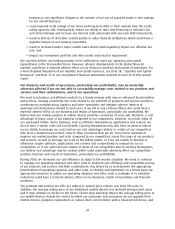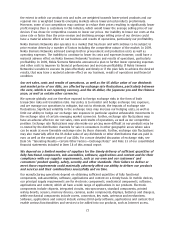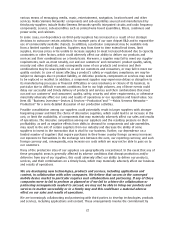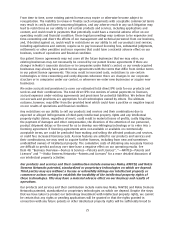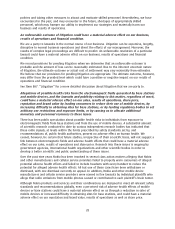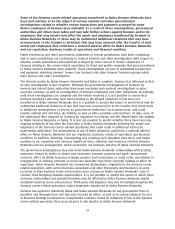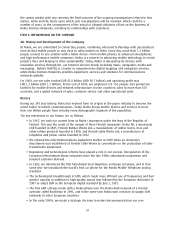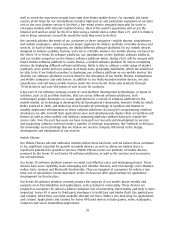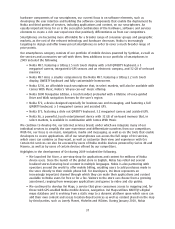Nokia 2009 Annual Report Download - page 29
Download and view the complete annual report
Please find page 29 of the 2009 Nokia annual report below. You can navigate through the pages in the report by either clicking on the pages listed below, or by using the keyword search tool below to find specific information within the annual report.control, tariffs or other fees or levies imposed on our products and services and environmental,
product safety and security and other regulations that adversely affect the export, import, pricing or
costs of our products and services, as well as new services including applications and content related
to our products, could also adversely affect our sales and results of operations. For example, copyright
collecting societies in several member states of the European Union claim that due to their capability
to play and store copyrighted content, mobile devices should be subject to similar copyright levies
that are charged for products such as compact disc, digital video disc or digital audio players. Any
new or increased levies and duties could result in costs which we may not be able to pass on to our
customers or in higher prices for our products and services and their combinations, which may impair
their demand. In addition, changes in various types of regulations or their application with respect to
taxation or other fees collected by governments or governmental agencies may result in unexpected
payments to be made by us.
The impact of changes in or uncertainties related to regulation and trade policies could affect our
business and results of operations adversely even though the specific regulations do not always
directly apply to us or our products and services, including applications and content. In addition to
changes in regulation and trade policies, our business may be adversely affected by local business
culture and general practices in some regions that are contrary to our code of conduct. Further, our
business and results of operations may be adversely affected by regulation and trade policies favoring
the local industry participants as well as other measures with potentially protectionist objectives
which host governments in different countries may take, particularly in response to difficult global
economic conditions.
Our operations rely on the efficient and uninterrupted operation of complex and centralized
information technology systems and networks. If a system or network inefficiency,
malfunction or disruption occurs, this could have a material adverse effect on our business
and results of operations.
Our operations rely to a significant degree on the efficient and uninterrupted operation of complex
and centralized information technology systems and networks, which are integrated with those of
third parties. All information technology systems are potentially vulnerable to damage, malfunction or
interruption from a variety of sources. We pursue various measures in order to manage our risks
related to system and network malfunction and disruptions, including the use of multiple suppliers
and available information technology security. However, despite precautions taken by us, any
malfunction or disruption of our current or future systems or networks such as an outage in a
telecommunications network utilized by any of our information technology systems, attack by a virus
or other event that leads to an unanticipated interruption or malfunction of our information
technology systems or networks could have a material adverse effect on our business and results of
operations. Furthermore, any data leakages resulting from information technology security breaches
could also materially adversely affect us. Also, failures to successfully utilize information technology
systems and networks in our operations may impair our operational efficiency or competitiveness
which could have a material adverse effect on our business and results of operations.
If we are unable to retain, motivate, develop and recruit appropriately skilled employees, our
ability to implement our strategies may be hampered and, consequently, could have a
material adverse effect on our business and results of operations.
We must continue to retain, motivate, develop through constant competence training, and recruit
appropriately skilled employees with a comprehensive understanding of our current and future
businesses, technologies, software, products and services. This is particularly the case in our
converged mobile devices business where we need highlyskilled, innovative and solutionsoriented
personnel. While we have reduced our personnel through various targeted measures due to difficult
global economic conditions and may need to do so further in the future, we seek to create a
corporate culture that is motivating, encourages creativity and continuous learning as competition for
skilled personnel remains keen. We are also continuously developing our compensation and benefits
27





